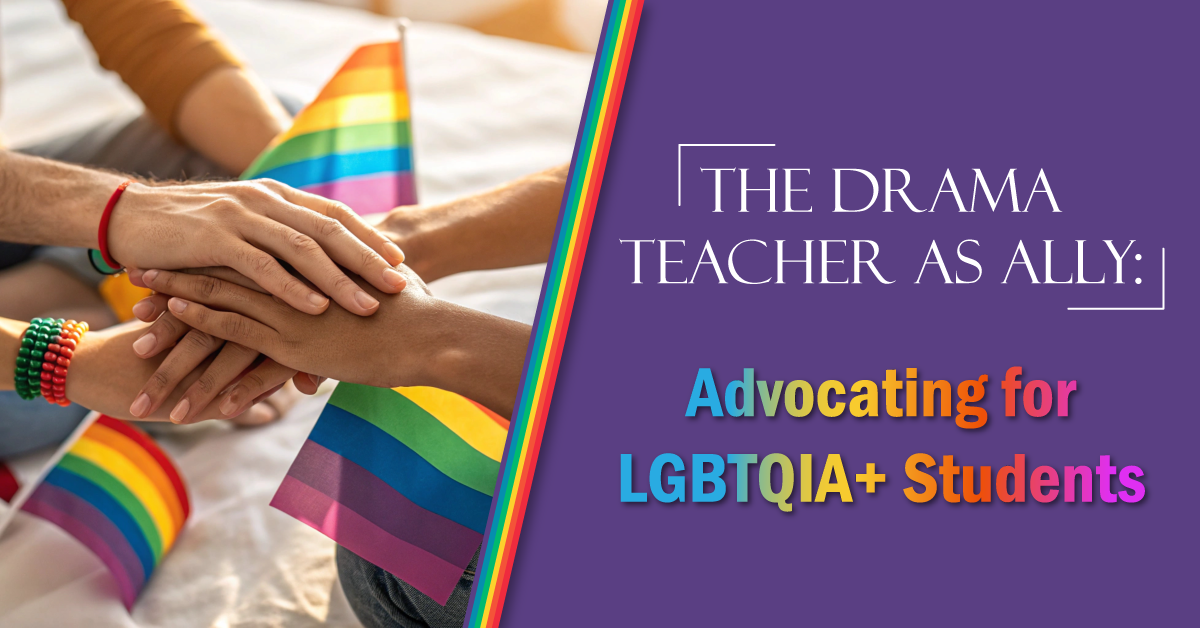The Drama Teacher as Ally: Advocating for LGBTQIA+ Students
The drama classroom is a unique space with tremendous potential for allyship and advocacy. It’s often a haven for students who feel “othered” in more traditional school environments, especially LGBTQIA+ students. Being a conscious, active ally in your drama classroom goes beyond just being welcoming; it means intentionally creating a space where all identities are seen, respected, and celebrated. Here are some tips for advocating for your students both within and beyond the drama classroom.
Advocating Within Your Drama Classroom
Within your classroom, you have the opportunity to model allyship daily. Your drama classroom can be the space where it’s safe to take risks, make mistakes, and try again. It’s a place where, given the opportunity, students can truly be themselves.
- Include a clear statement in your syllabus and classroom agreements about respect, inclusion, and anti-discrimination.
- Let students know that misgendering, homophobic language, and transphobic behaviour won’t be tolerated.
- Choose plays and texts that include queer voices and characters, and work by LGBTQIA+ playwrights. Include these choices as part of your regular teaching, not just in a “Pride unit.” Choose pieces that celebrate and uplift LGBTQIA+ joy, representation, and excellence.
- Offer flexible casting options. For example, instead of saying “We need a girl to play Juliet,” try “We need someone comfortable with Juliet’s role — anyone interested?”
- In playwriting, devised theatre, and improv, let students develop characters and performances that reflect their lived experiences, while still respecting their boundaries.
- Always use consent-based practices in physical theatre exercises, blocking, and ensemble work. For example, always ask “Is it ok if I place my hand on your shoulder here?” rather than physically moving an actor into place.
- Lead conversations on how theatre can be a tool for social change and visibility.
- Introduce and discuss intersectionality: how gender, sexuality, race, and class all interact in performance and casting.
Advocating Beyond Your Drama Classroom
Expanding your advocacy beyond the classroom is where real systemic change can start to take root. As a teacher and an ally, you can use your voice and position to improve the broader school culture for LGBTQIA+ students.
- Collaborate with your school’s GSA (Gender & Sexuality Alliance), or help start one if it doesn’t exist. Volunteer your classroom as a meeting space, or offer to be a staff advisor.
- Seek out professional development opportunities that centre on inclusive education and equity, especially ones taught by members of the LGBTQIA+ community. Look for topics such as inclusion, intersectionality, and trauma-informed approaches. Share these learning opportunities with your colleagues.
- Support inclusive school policies, such as gender-neutral bathrooms, dress code updates, and curriculum representation. Push for school forms and databases to include preferred names and pronouns.
- Speak up in staff meetings and curriculum discussions when LGBTQIA+ issues are being ignored or minimized. If necessary, partner with like-minded colleagues to present a unified front when advocating for change.
- Be a mentor and visible ally to colleagues. Other staff might want to be allies but feel unsure or nervous. Your openness and willingness to learn can inspire others.
When LGBTQIA+ students see their identities respected beyond one safe classroom (hopefully, yours!), it helps to build a school environment where they can actually belong and thrive. Even small acts of advocacy can and will ripple outward.



